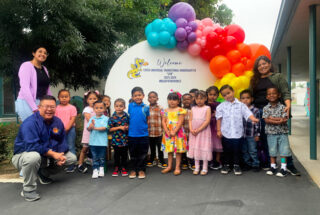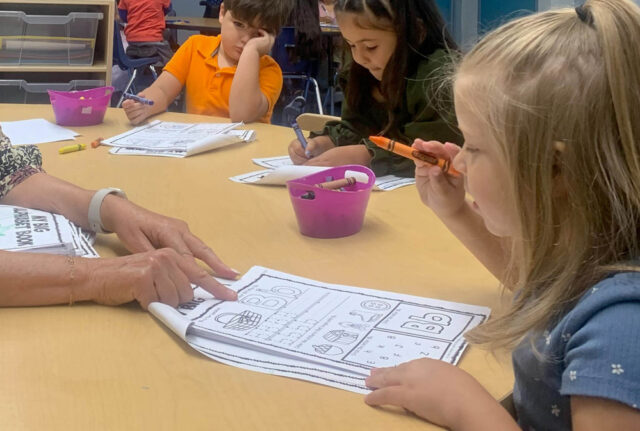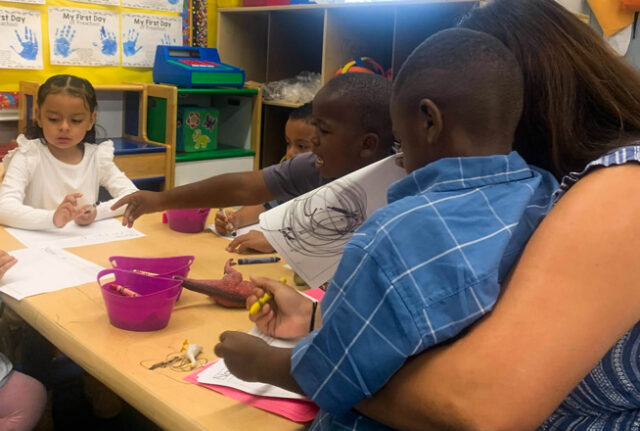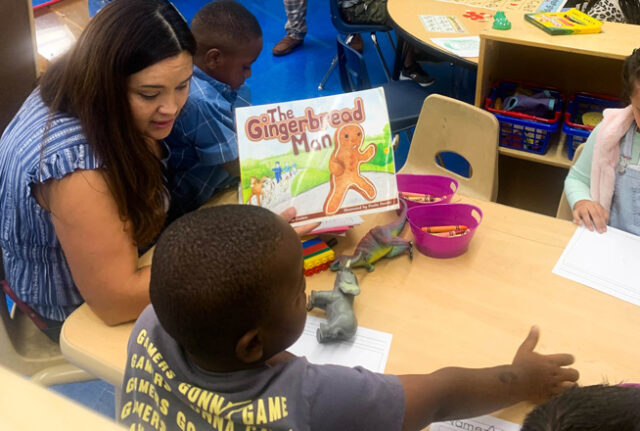As the new school year begins, hopes are high for LAUSD pre-K for four-year-olds
Charles Hastings | September 26, 2023
Your donation will help us produce journalism like this. Please give today.

Four-year-olds have class at 135 Street Elementary School where they have the newly implemented Universal Transitional Kindergarten. (Charles Hastings)
Outside 135th Street Elementary School in Gardena, a colorfully-decorated sign welcomes pre-K students — boasting they will be “#ready4theworld!” with the help of Los Angeles Unified’s new universal program for young learners.
“We want to hear smiles,” said Dean Tagawa, executive director of early child education for LA Unified who is overseeing the district’s new Universal Transitional Kindergarten program for 4-year-olds.
Hopes are high the new classes will help bolster declining literacy rates in California and provide an enrollment boost for the district, which has attracted thousands of brand new young students to LAUSD schools.
After seeing the success offering pre-K dual language and special education classes to 14,000 students as of last May, the district has opened the doors to all 4-year-olds for the free UTK program, enrolling an additional 5,000 this academic year in more than 480 schools. The district had hoped to enroll an additional 10,000 to 11,000 young students.
“Early investment really sticks with kids long-term,” said Tagawa, “You can just see it.”
Inside Lourdes Serrano’s UTK dual-language classroom, the investment comes in the form of hands-on learning of concepts that will also be taught in kindergarten — letters and numbers, and social skills, but at a slower and more deliberate pace for the younger students.
Obstacles do come with such an early introduction into the classroom. Teachers do not potty train students. Attachment to parents becomes a more prevalent issue.
“The first day of school, all of these kids cried,” said Serrano, a teacher at 135th Street Elementary.
Yet, the benefits of early education are clear: With young learners in classrooms, it allows students to more likely earn higher wages, score higher on exams and graduate high school, according to the National Education Association.
UTK teacher Teri Anderson is working hard in her classroom at 135 Street Elementary School to prepare her young students for the future.
“Everyday learning is really a superpower,” Anderson said while teaching children to practice drawing the letter “B” on a worksheet. “I look at these kids, they’re like little sponges. The LAUSD funds us well, and it really gives us an opportunity to work with [kids] right where they start.”
In Anderson’s class, colored furniture complemented by endless crayoned art work of birds and trees adorn the walls. Classes are small, with a 6-1 ratio of teachers to students, helping young children be prepared for kindergarten classes.
“They’re young,” said Serrano, “…but they’re prepared for kindergarten, socially, and even sometimes academically.”
Kids regularly use Play-Doh to sculpt letters in both languages in Serrano’s classroom, while simultaneously learning the various pronunciations.
“We start with Spanish in the morning now, with English in the afternoon,” Serrano said.
Tagawa acknowledged that some parents may have concerns that such young children attending school is not productive, but emphasized the district would focus on “developmentally appropriate” skills.
“As long as the students come,” said Tagawa, “we’re in a really good place.”
Charles Hastings is an exchange student from Trinity College Dublin, currently a junior at USC. He has written for publications including the University Times, Get a Grip Magazine, and his college publication, Trinity News.


